Marmara Bölgesi’nde pnömoni görülen sığır, koyun ve keçilerin akciğerlerinden izole edilen etkenlerin bakteriyolojik yöntemlerle araştırılması ve epidemiyolojisi
Künye
Kucuk Baykan, Z. , Tabak, M. H. , Kılıç, A. , Gün, H. & Mete, A. (2023). Marmara Bölgesi’nde Pnömoni Görülen Sığır, Koyun ve Keçilerin Akciğerlerinden İzole Edilen Etkenlerin Bakteriyolojik Yöntemlerle Araştırılması ve Epidemiyolojisi . Kocatepe Veterinary Journal , 16 (2) , 209-218 . DOI: 10.30607/kvj.1208946Özet
Bu çalışma ile pnömoni görülen sığır, koyun ve keçilerin akciğerlerinde tespit edilen bakterilerin, izole edildikleri hayvan türleri, yaşlarının yanı sıra izole edildiği bölge ve mevsime göre dağılımlarının istatistiksel olarak değerlendirilmesinin yanında güncel epidemiyolojik verilerin oluşturulması hedeflendi. Akciğer örneklerinden (152 adet) izole edilen bakteri oranları; Streptococcus spp. %37,5, Mannheimia haemolytica (M. haemolytica) %26,3, Pasteurella multocida (P. multocida) %11,8, Staphylococcus spp. %9,2, Pseudomonas aeruginosa (P. aeruginosa) %5,3, Klebsiella pneumoniae (K. pneumoniae) %5,3, Moraxella spp. %4,6 olarak saptandı. Bir yaşından küçük hayvanların akciğerlerinden; Streptococcus spp. %33,3, M. haemolytica %25,5, P. multocida %11,8, Staphylococcus spp. %9,8, P. aeruginosa %5,9, K. pneumoniae %9,8, Moraxella spp. %3,9; 1 yaşından büyüklerde Streptococcus spp. %39,6, M. haemolytica %26,7, P. multocida %11,9, Staphylococcus spp. %8,9, P. aeruginosa %5, K. pneumoniae %3 ve Moraxella spp. %5 olarak saptandı. Çalışmada bakteri izolasyon oranlarının en yüksek olduğu iller; Bursa %15,79, Kocaeli %14,47 ve Kırklareli %13,16 olarak hesaplandı. Bu çalışmanın sonuçlarının solunum sistemi infeksiyonlarına karşı koruma-kontrol protokollerinin oluşturulmasına, sürü sağlığı yönetimine ve bilimsel literatürlere katkı sağlanacağı düşünülmektedir. The aim of this study is to identify the bacteria encountered in the lungs of cattle, sheep, and goats with pneumonia and to statistically evaluate the distribution of the detected bacteria based on age, species, seasons, and provinces to generate updated epidemiological data. The rates of bacteria isolated from 152 lung samples: Streptococcus spp. 37.5%, Mannheimia haemolytica (M. haemolytica) 26.3%, Pasteurella multocida (P. multocida) 11.8%, Staphylococcus spp. 9.2%, Pseudomonas aeruginosa (P. aeruginosa) 5.3%, Klebsiella pneumoniae (K. pneumoniae) 5.3% and Moraxella spp. 4.6%. In this study, the bacteria isolated from animals less than one year old were: Streptococcus spp. 33.3%, M. haemolytica 25.5%, P. multocida 11.8%, Staphylococcus spp. 9.8%, P. aeruginosa 5.9%, K. pneumoniae 9.8%, and Moraxella spp. 3.9%. The older animals were: Streptococcus spp. 39.6%, M. haemolytica 26.7%, P. multocida 11.9%, Staphylococcus spp. 8.9%, P. aeruginosa 5.0%, K. pneumoniae 3.0%, and Moraxella spp.5%. The provinces with the highest bacterial isolation rates were: Bursa 15.79%, Kocaeli 14.47%, and Kırklareli 13.16%. In conclusion, this study will contribute to the development of protection-control protocols against respiratory infections, management of herd health, and literature.
Kaynak
Kocatepe Veteriner DergisiCilt
16Sayı
2Koleksiyonlar
- Cilt 16: Sayı 2 [14]



















